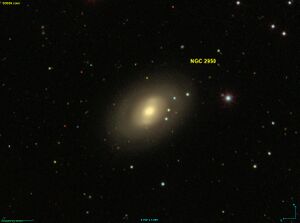Astronomy:NGC 2950
| NGC 2950 | |
|---|---|
 SDSS image of NGC 2950 (center) | |
| Observation data (J2000 epoch) | |
| Constellation | Ursa Major |
| Right ascension | 09h 42m 35.116s[1] |
| Declination | 58° 51′ 04.39″[1] |
| Redshift | 0.004410 ± 0.000017 |
| Helio radial velocity | 1,329[2] km/s |
| Distance | 49.84 ± 0.46 Mly (15.28 ± 0.14 Mpc)[2] |
| Apparent magnitude (B) | 11.93[2] |
| Characteristics | |
| Type | RSB0(r)[3] |
| Apparent size (V) | 2′.7 × 1′.8[3] |
| Other designations | |
| NGC 2950, UGC 5176, PGC 27765[4] | |
NGC 2950 is a lenticular galaxy in the northern constellation of Ursa Major, about 50 million light years from the Milky Way and receding with a heliocentric radial velocity of 1,329 km/s.[2] It was discovered in 1790 by the Anglo-German astronomer William Herschel.[5] NGC 2950 is a field galaxy, it is not part of a galaxy cluster or galaxy group, and thus is gravitationally isolated.[6] Nine certain and four possible dwarf galaxies have been identified around NGC 2950.[7]
The morphological classification of this galaxy is RSB0(r),[3] indicating a barred lenticular galaxy (SB0) with outer (R) and inner (r) ring structures. It hosts two nested stellar bars; the rotation frequency of the secondary bar is higher than that of the primary one.[3] Double bars of this type are relatively common, having been found in ~30% of barred lenticulars. The inner bar appears to be counter-rotating relative to the outer bar,[8] with the two passing cleanly through each other.[9] The stellar mass of the galaxy is 1.7×1010 M☉ while the halo mass is 6.6×1011 M☉.[7]
References
- ↑ Jump up to: 1.0 1.1 Skrutskie, Michael F. et al. (February 1, 2006). "The Two Micron All Sky Survey (2MASS)". The Astronomical Journal 131 (2): 1163–1183. doi:10.1086/498708. ISSN 0004-6256. Bibcode: 2006AJ....131.1163S.
- ↑ Jump up to: 2.0 2.1 2.2 2.3 Tully, R. Brent et al. (October 2013), "Cosmicflows-2: The Data", The Astronomical Journal 146 (4): 25, doi:10.1088/0004-6256/146/4/86, 86, Bibcode: 2013AJ....146...86T
- ↑ Jump up to: 3.0 3.1 3.2 3.3 Corsini, E. M. et al. (December 2003). "Direct Confirmation of Two Pattern Speeds in the Double-barred Galaxy NGC 2950". The Astrophysical Journal 599 (1): L29–L32. doi:10.1086/381080. Bibcode: 2003ApJ...599L..29C.
- ↑ "NGC 2950". SIMBAD. Centre de données astronomiques de Strasbourg. http://simbad.u-strasbg.fr/simbad/sim-basic?Ident=NGC+2950.
- ↑ Seligman, Courtney (2016). "NGC 2950 (= PGC 27765)". Professor Seligman. http://cseligman.com/text/atlas/ngc29a.htm#2950.
- ↑ "NASA/IPAC Extragalactic Database". http://ned.ipac.caltech.edu/cgi-bin/objsearch?objname=NGC+2950&extend=no&hconst=73&omegam=0.27&omegav=0.73&corr_z=1&out_csys=Equatorial&out_equinox=J2000.0&obj_sort=RA+or+Longitude&of=pre_text&zv_breaker=30000.0&list_limit=5&img_stamp=YES.
- ↑ Jump up to: 7.0 7.1 Tanaka, Masayuki et al. (October 2018). "The Missing Satellite Problem Outside of the Local Group. I. Pilot Observation". The Astrophysical Journal 865 (2): 12. doi:10.3847/1538-4357/aad9fe. 125. Bibcode: 2018ApJ...865..125T.
- ↑ Maciejewski, Witold (September 2006). "Response of the integrals in the Tremaine-Weinberg method to multiple pattern speeds: a counter-rotating inner bar in NGC 2950?". Monthly Notices of the Royal Astronomical Society 371 (1): 451–458. doi:10.1111/j.1365-2966.2006.10679.x. Bibcode: 2006MNRAS.371..451M.
- ↑ Maciejewski, W. (October 2008). "Orbits in Corotating and Counterrotating Double Bars". in Funes, José G.; J., S.; Corsini, Enrico Maria. Proceedings of the conference held 1-5 October, 2007 at the Centro Convegni Matteo Ricci, Rome, Italy. 396. San Francisco: Astronomical Society of the Pacific. p. 367. Bibcode: 2008ASPC..396..367M.
External links
 |

